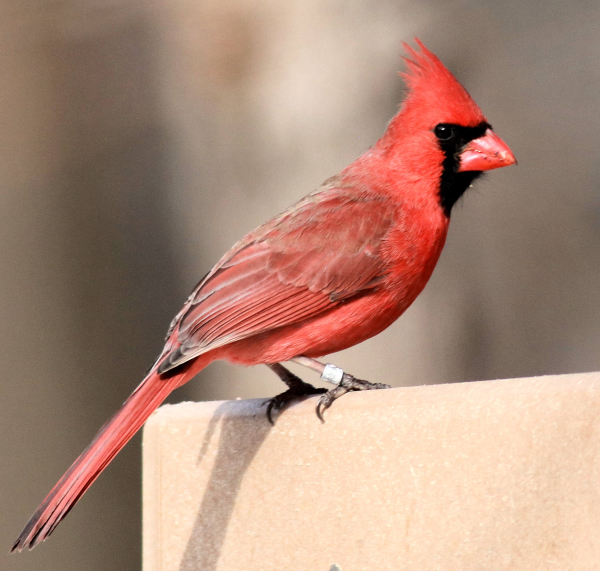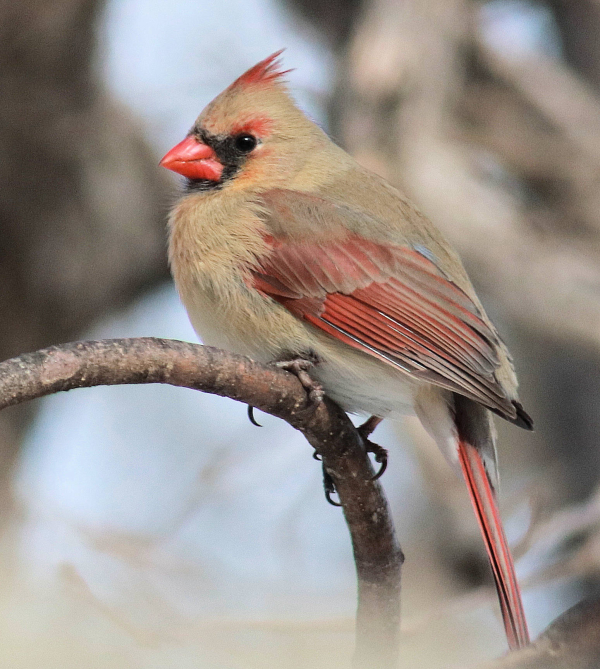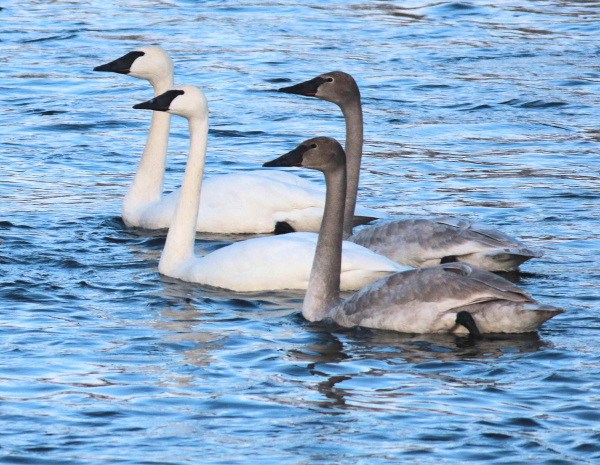
After not observing Northern Cardinals close at hand for some time, Paul marveled at just how spectacular cardinals are, and wished they ranged a few hundred miles farther northwest. If you have cardinals at your feeding station, cherish each visit!

At times, Paul counted as many as three females and three male Northern Cardinals at once.

Trumpeter Swans are remarkable birds that capture your attention and add appreciably to the wild landscapes of North America.
|
I started last week with two wide-ranging drives that took me from the Missouri River to the Mississippi River, not by the shortest route, but cross-country from Bismarck to Minneapolis, about 470 miles one way. Northern Cardinals have long been a tough species for me to get good photographs of, even at feeders, but Thursday I was rewarded with my best cardinal images at Lowry Nature Center, a favorite haunt west of Minneapolis. Other feeder birds there included a Red-bellied Woodpecker and a flock of American Tree Sparrows among Black-capped Chickadees, Blue Jays, and White-breasted Nuthatches.
The prize sighting for the day was the last bird I observed – a big Pileated Woodpecker in flight above my van as I drove through a beautiful woodland near St. Cloud, Minnesota. And that was after visiting the mega-waterfowl concentration on the Mississippi River at Monticello (St. Cloud and Monticello are northwest of Minneapolis). The Trumpeter Swans provide such an exceptional experience as they swim, feed, fly, and interact along the freezing river’s shore in the company of Mallards and a few Canada Geese. The brassy trombone-sounding calls of the swans are tremendous and they provided background sounds as I watched eight drake Mallards displaying for a hen that swam her way through the assemblage of potential mates. Nesting season is still two-plus months away, but many pair bonds have already been forged among these common ducks.
There were also species-specific flocks of these waterfowl in the Fergus Falls area far to the north of Monticello. There the little Otter Tail River flows through the winter, holding some swans, geese, and ducks in the area. In addition to seeing flocks of 8, 6, 2, and 4 Trumpeters in flight in the area, I viewed a rather grizzly act of nature. A Common Raven, a rare bird in the area, was beginning to scavenge a recently grounded Trumpeter while standing on the huge bird’s frozen body. I certainly wondered what this grand swan succumbed to, but I knew that at this crucial time of the year it will provide much-needed nourishment for other animals; nonetheless, it was a sad sight.
Eagle Attacks
Fergus Falls is about halfway between Minneapolis and home, and it’s where I turn west after traveling northwest from the Twin Cities to Fergus. About an hour west, in southeastern North Dakota, I spotted both of North America’s two species of eagles within 10 minutes – and both made hunting attacks as I observed them. The adult male Golden Eagle, a rare sighting in this region, made a low direct flight to approach and attack a Fox Squirrel as it ran across an open stretch of snow. The eagle smacked the squirrel, and I saw the squirrel’s tail flail with the impact, but the rufous rodent jumped out of the fray and sped to a stand of trees to escape. I was surprised the eagle didn’t try again, but after a moment to regain its composure, it took flight and glided along a line of trees, catching an updraft on the south wind before perching in a tree a half mile to the east.
A little farther down the road, I intercepted a big adult female Bald Eagle that I watched fly along a stand of trees then dip low over an open grassland. She hovered a few moments, which was a bit of a surprise in itself to see such a big bird hovering. I looked below the eagle to see what animal she might be targeting, then the eagle suddenly dropped to the snow, hesitated a moment, then took flight again. I still didn’t see any evidence of potential prey, but maybe a small rodent I couldn’t see had enticed the big raptor. In addition to a few scattered pheasants along the way, I found wintering flocks of 9 American Robins and 6 Blue Jays at different wooded farmsteads along the way.
Owl Checks
The day before I drove to Minneapolis, I had to do an errand in Bismarck, so on my way I stopped to check for the two Snowy Owls I’ve been monitoring near the town of Steele, about 40 miles east of Bis. I searched the area in earnest to find one or both of the Snowy Owls but my midday survey was thwarted by no white owl sightings. Even so, during my return home I had another chance to search again, but about two miles before I reached my usual survey area I spied a Snowy Owl perched high atop a metal powerline tower.
It turned out to be a female, undoubtedly the female I’ve been finding during the past month. After documenting her photographically from afar, I quickly re-checked the area to the north for the male I’ve been seeing, but I found no hint of the nearly pure white Snowy. Before I hit the road again, I drove back to a location where I could get a better look at the female as the red-orange sun colored the owl and the surrounding snowscape a pinkish hue.
As I continued on my way east, about 11 miles down the road I was glad to see a Great Horned Owl hunting on the edge of a frozen, snow-covered marsh. The only other bird I observed that day aside from a few widely scattered Horned Larks was an adult Bald Eagle that caught my attention earlier in the afternoon, when I saw the sunlight flash off its back as it soared in spirals ahead of me. I pulled to the side of the road with the hope that it would soar above me. At first it appeared my hope was unwarranted as the eagle angled away, but suddenly it took another circular orbit and ended up on a glide that passed overhead – beautiful.
Seasonal Changes?
Last Tuesday provided a sunny break from the overcast conditions imposed during far too many January days, heralded by the sound of Hairy Woodpeckers drumming as though they were inspired by the morning sun. We all know how sunshine can change our perspective, and it’s the same for birds. Then too, the daylight period continues to increase daily, and soon that will trigger birds into spring behaviors and migrations.
The Minnesota sunshine and 26 degree temperatures also jazzed me up a bit Wednesday and Thursday with what must have been a little spring fever. Back home Friday morning, after experiencing three productive days that included fun birding episodes, when I checked one of the trees in my front yard, I caught the motion of a Red-breasted Nuthatch, the first I’ve seen in months – that’s a good sign of a change of seasons, right? During a Saturday afternoon survey of the area north and south of my office, scattered pheasants were the only birds that showed themselves. But the last rooster I passed reared his head back and crowed while flapping his wings – that’s definitely a good sign. C’mon spring!
Wherever you are, whatever the clime, enjoy winter birding as it exists in your area; and if you visit another area of the country or beyond, absorb the great outdoors and appreciate birds wherever you find them. With birds like Snowy Owls, Red-bellied and Pileated Woodpeckers, Trumpeter Swans, Northern Cardinals, Bald and Golden Eagles, and many other exciting species, my birding week was certainly fulfilling. And hey, Sunday afternoon a little Red-breasted Nuthatch quickly zipped in a grabbed a shelled sunflower seed from my hopper feeder – repeatedly. Enjoy your week!
Article and photos by Paul Konrad
Share your bird sightings and photos at editorstbw2@gmail.com